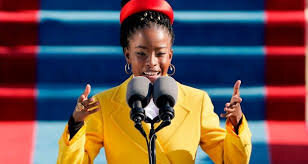The Presidential Inauguration
Amanda Gorman, American Youth Laureate -Photo: Irish Times
I still recall so vividly the threatening and ominous speech at the 2017 inauguration from Joe Biden’s presidential predecessor. The messages this time round, of hope, humanity and connection after such a troubling few weeks, months and years were uplifting and brought tears to my eyes.
Kamala Harris shattered the glass ceiling when she was sworn in as vice president. In almost a quarter of a millennium there had never been a woman to hold nationally elected office EVER. And, of course, she is the first Black woman and Asian American to do so too. Ms Harris was only the second Black woman to be elected to the Senate EVER. Her achievement must be a huge inspiration for young women, and particularly those young women of colour.
There was more than a hint of this in the stunning poem: ‘The Hill We Climb’ from the American Youth Laureate, Amanda Gorman, who was the first person to use the term “Madam Vice President” EVER. In addressing the inauguration ceremony, she cleverly talked about a young, skinny black girl, descended from slaves, raised by a single mother dreaming of becoming President only to find herself reciting to one.
The hope is that whether it’s through a diverse Vice-President, the American Youth Poet Laureate, a German Chancellor or New Zealand Prime Minister, young women will feel that reaching high office is something that they can realistically aspire to. It’s what was hoped for, for black youngsters, when Barack Obama became President 12 years ago.
So, these role models, one would hope, would be inspiring diverse young people. But I think there’s something else here, which is important, particularly for people maybe like me – white, male – so the majority population here in the UK. And this is about representation. We can think about representation, say in the workforce, in leadership positions. We know that women, minority ethnic people and those with disabilities are under-represented. The default can so often be white, male, able-bodied etc.
Actor Sir Lenny Henry, with the former Chair of the Royal Television Society's Diversity Committee, Marcus Ryder, have just had their book, ‘Access All Areas: The Diversity Manifesto for TV and Beyond’ published. He relates calling the Office for National Statistics to confirm a hunch. They told him that only 29.5% of the United Kingdom's population is made up of white, heterosexual, able-bodied men; so, he wondered why do they still make up the vast majority of people we see in our media?
This isn’t fair, but what should also concern us also is that impact it has on us subliminally. What we see in the media, in our workplaces and in our community contributes to the assumptions we make and yes, those unconscious biases. We fall into the trap of making such assumptions – engineers are male, care workers are female – because that’s so often our experience.
During the presidential campaign, Biden promised more diversity in his government. The laureate Amanda Gorman provided a super-charged emotional high-point in a veritable cavalcade of diversity, so ironic at the inauguration of a 78-year old white man as President. The choice of the officiators at the ceremony: judges, pastors, senators, was a powerful visual challenge to the hegemony of white and male leaders that we see around us. And it was representative of an increasingly diverse nation.
Closer to home, I researched the gender representation of the Holyrood and Westminster COVID briefings. Like Sir Lenny, I had a hunch that the Westminster briefings were male-dominated. Holyrood showed diversity, with a female First Minister. But at Westminster, apart from a couple of appearances by the Home Secretary, for ten months the briefings were devoid of women.
Women take a majority of caring and family responsibilities and looking after children and they account for 77% of the NHS workforce, yet the representation we see is men communicating (and making?) decisions which have an even larger impact on men and women. Could we be forgiven for the implicit assumption that women are not to be trusted with leadership or communications in this existential threat that is the pandemic?
We don’t all have the opportunity to choose a team from scratch. So what can we do in our own roles and lives? I’d say, make the unconscious conscious. Look around you, in your workplace, community, congregation, in your newspaper, in the media. Does what you see reflect the diversity of society? What part can you play in raising awareness of this, of making changes?
I was recently talking to Media Studies students at Portobello High School who are doing a project on representation in the media. They were studying Jordan Peele’s thriller movie – “Get Out” – which challenges pernicious and lazy stereotypes that can be experienced by black people, through the character played by black actor, Daniel Kaluuya. These students were following the advice that Mrs Biden Senior would give to the future president, the young Jo, to “put yourself in other people’s shoes.” By understanding what might get in the way of the skinny young black girl fulfilling her presidential dream we might just be able to help her get there.

